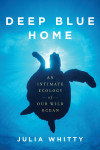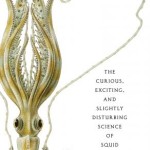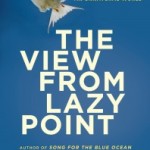
If you are looking a fact-based text on the ecology the oceans, Deep Blue Home is not for you. If you are interested in the ecology of one woman’s personal connection to the seas – a woman who has studied, wrote, filmed and promoted a greater understanding for our troubled waters – then you will find Julia Whitty’s historical travelogue cum biography a pleasurable narrative to read as I have.
Julia Whitty is a writer, filmmaker, and environmental correspondent for Mother Jones Magazine and has written several books about the marine environment. Her blog Deep Blue Home is a personal favorite of mine where takes an integrative approach to issues in marine science and conservation, often with a fascinating historical slant to it.
Deep Blue Home starts at Isla Rasa in the Gulf of California and takes us through her experiences there as a volunteer conducting sea bird research. It is through her eyes that we learn about the delicate conservation ecology of the area, the interaction between local subsistence fishermen and egg-harvesters and the seabirds (and the researchers), and how these experiences shaped her view of ecology. Wrapped around the many meanings of ‘rasa’ from Spanish and Hindi languages she narrates us through ocean circulation patterns, life history characteristics of “Earth’s truest nomads” – the jelly Aurelia aurita, and populations dynamics of a diverse community surrounding her tiny island microcosm. She has this intriguing ability to write herself into the ecosystem she is observing, a vital lynchpin that connects the human to the wild.
Like most of Rasa’s migrators, I arrive here at the end of my resources – in my case, with exactly 10 dollars in my pocket and only a vague notion of how I’ll get home at the end of the field season, or where home is anymore.[…] I bemoan my species advancements – the loss of fur, the insistence on bipedalism – which have forced us to invent technological substitutes for the technology other species carry onboard, no baggage needed. (pg.51)
The second section find Julia at the northern extent of the Gulf Stream off of Newfoundland filming murres, puffins and whales. She uses this opportunity to embellish us with a deeper understanding of the interconnectedness of people to their environment. This section is immediately relevant as it deals with environmental sagas that seem all too familiar these days. Transformation of local marine ecology by the presence and activities of oil industry off the infamous fisheries grounds called the Grand Banks. She masterfully peppers in history and facts with capelin and storm-petrels.
The capelin scull is transforming the beach under our feet. Roe, ripened inside cool female bodies during their tenure in the cold, is filling the the interstices of sand with millions of lustrous amber globes little bigger than poppy seeds. Despite the overcast and snow, these eggs gleam with the sheen unique to seaborne life – a mass stranding of glass fishing floats from a miniature world. They glisten among the multicolored pebbles of quartzite, sandstone, limestone, and shale, ground from the land by the waves. They sparkle beside the pulverized remains of Newfoundland’s beach fossils, its trilobites and the earliest jellyfishlike animals.
I get the feeling that this style of writing comes a well-informed background in marine biology. It is too well-researcheded to be passed off as ecology-fluff. Julia goes as far as to list the endangered species status of each species she discusses and defines their latin names. I come away from Deep Blue Home feeling that this is a book that really cares both about conveying passion and ensuring scientific accuracy.
Finally, and most relevant to my own personal interests, she describes the alien environment of the deep sea as the “existence of a world previous to ours”. She tags along on research expedition studying whale falls, hydrothermal vents and methane seeps. As my extensive experience in this area has provided me with a biased eye on the science, I am fascinated by reading my beloved deep through her eyes. She has been all over the high seas experiencing and writing about so many marine environments during her career, yet now she is in my turf. Because of Julia’s breadth, she is able to make connections and put these disparate habitats in context. I especially appreciated her detail of the crew and scientists on these ships – some whom I know – and capture the spirit and quirks of expeditionary science.
Deep Blue Home is part history, part science, part ocean ecology and part personal narrative. The value added of having one like Julia Whitty writing a book like this, is a lifetime of context in which to convey an appreciation of the total oceanic environment from the subtropical confines of Isla Rasa to the cliffs of Newfoundland rookeries to the worm-ridden bottom of the ocean. This is not a fluff piece about how we must save the ocean, as much environmental writing tends toward. This is an experiential piece from a well-informed woman that sees the connections among human, environment and sea life. I think the average Deep Sea News reader would gain a unique perspective and learn much about the history and humanities aspect of our deep blue home, aspects that are often forgotten amidst the conservation emphasis these days.






Thanks for posting this review. I’ve had this book on my list for a while, but I kept pushing it back. I didn’t realize what I was missing.